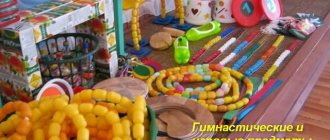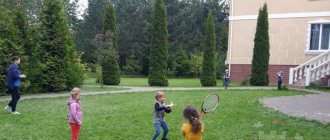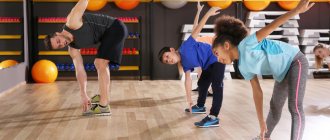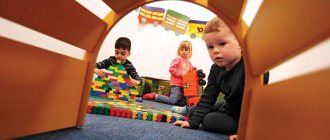Organization of a targeted walk in a preschool educational institution
ORGANIZATION OF A TARGETED WALK IN A preschool educational institution
The importance of a walk in a child's life.
Walking is a reliable means of promoting health and preventing fatigue. Staying in the fresh air has a positive effect on metabolism, increases appetite, and the absorption of nutrients, especially the protein component of food. Children's stay in the fresh air is of great importance for physical development. Walking is the first and most accessible means of hardening a child’s body. It helps to increase its endurance and resistance to adverse environmental influences, especially colds. Reducing the time spent in the air creates a lack of movement.
Walking promotes not only physical, but also mental education. While staying on the site or on the street, children receive many new impressions and knowledge about their surroundings: about the work of adults, about transport, about traffic rules, etc. From observations, they learn about the features of seasonal changes in nature, notice connections between various phenomena , establish an elementary dependency. Observations arouse their interest and a number of questions to which they strive to find an answer. All this develops observation, expands ideas about the environment, awakens the thoughts and imagination of children.
Walk
is a pedagogically organized form of active recreation for children in the fresh air, the purpose of which is to strengthen the health of children and develop their physical and mental abilities.
Walking objectives:
• optimize children's physical activity;
• have a hardening effect on the body;
• promote the development of observation and cognitive abilities of children;
• introduce children to their native land, its attractions, and the work of adults;
• development of children's independence.
It should be noted that a walk is an element of the regime that gives children the opportunity to satisfy their needs for movement in outdoor games, work processes, and various physical exercises. If the walk is well and properly organized, if it is of sufficient duration, children realize about 50% of the daily need for active movements in it. Reducing time spent in the fresh air creates a lack of movement.
The preschool uses different types of walks. Conventionally, they can be classified
in the following way:
1. At the venue:
- on the territory of the kindergarten;
- outside the territory of the kindergarten (possible in older groups, over short distances).
2. By content:
- traditional, which includes children’s work activities (cleaning up leaves, snow, etc.), active and quiet games, etc.;
- thematic: consisting of observations and conversations on a specific topic (animals, clouds, trees, city transport, etc.), can be a street theater performance, a quest with overcoming simple obstacles - requires a pre-prepared script;
- target: organized exit outside the territory of the kindergarten, over a short distance (up to 2 km);
- excursion (usually a museum tour): should be held at least once a month, starting with the middle group;
- hike: can be carried out 1-2 times a year in older groups.
Starting from the second youngest group, targeted walks
throughout the site and beyond. Taking into account the natural environment of the kindergarten, the most striking seasonal natural phenomena, the capabilities of the children, and the work done with them, the teacher decides where to go and what to see. On such a walk, the main task is highlighted - to familiarize children with a phenomenon or object of nature to expand and clarify children's impressions.
On targeted walks, children get acquainted with nature in natural conditions: in the forest, in a meadow, in a garden, by a pond, etc. Targeted walks are carried out during the hours allotted for them. Targeted walks have a specific program content, the assimilation of which is mandatory for all children in the group (which differs from everyday walks). The educational value of targeted walks is very great, as they increase interest in native nature and contribute to the development of aesthetic feelings.
Staying in the fresh air in a forest or meadow among fragrant flowers, movement and joyful experiences usually associated with this, also have a beneficial effect on the physical development of children. The choice of place for targeted walks depends on its objectives and the age of the children.
Purposeful walks are widely used to introduce children of all age groups to nature. This is the main form of organization for children when becoming familiar with nature. They can combine the nature of targeted walks, during which the teacher conducts inspections of the site, organizes observations of the weather, seasonal changes in the life of plants and animals. Conduct targeted walks and observations of the condition of recreation areas after weekends, conversations about the impact of pollution on the life of plants and animals. Conversations are accompanied by reading fiction about the role of nature in human life and showing illustrations.
Targeted walks are carried out at certain hours according to a pre-developed plan, coordinated with the educational program. On them, the teacher not only tells the children new information ,
but also clarifies and consolidates the knowledge they already have.
Targeted walks are structured so that in the process of getting to know nature, children develop their cognitive abilities (observation, thinking) and speech, enrich their vocabulary, and cultivate interest and love for nature. The main thing is that all children master the program material. For this purpose, a variety of methods are used: observation of natural objects, the work of adults, didactic games, working with paintings, reading works of art, stories, conversations, etc.
The selection of objects for targeted walks is largely related to the location of a particular institution in relation to the kindergarten.
In the older group, school becomes the central object of familiarization. Graduates of preschool educational institutions enter secondary schools, so the kindergarten strives to maintain continuity in work with the school, holding joint events and targeted outings for preschoolers. The close proximity to a secondary school, for example, allows for targeted walks, joint holidays with primary school children, and attendance at the solemn holiday on September 1 - “Knowledge Day”.
On targeted walks, the teacher organizes games using natural materials (sand, snow, water, leaves), toys driven by wind, water, during which children accumulate sensory experience and learn the various qualities of natural objects.
Targeted walks outside the kindergarten are carried out with senior and preparatory school groups.
Taking into account the physical capabilities of preschoolers, for targeted walks you should first of all use nearby places. In cities there are boulevards, gardens, parks, ponds, where you can observe seasonal changes in the life of plants, birds, insects, as well as the work of people. In rural conditions, such places will be a forest, field, meadow, river, poultry house, barnyard, greenhouse, etc. It is advisable to carry out targeted walks to the same places at different times of the year. This makes it much easier for children to observe the seasonal changes that occur in nature.
Organizing a targeted walk.
When preparing for targeted walks, the teacher visits in advance the places where they are planning to go. Here he decides, based on the program, what can be shown, what should be taken with him for various gatherings, how to organize observation, what questions and tasks to give to the children, what games to play, where to have a rest.
Children are warned the day before about the upcoming target walk, telling them where they will go, what they will observe, what they should take with them to collect and transport plants and animals, and how to dress. Such a preliminary short message creates a good mood in children, arouses interest, and attracts their attention to the planned walk.
The organization of children plays an important role in conducting a targeted walk. Before leaving, they check that they have taken everything they need. Then they remind the children how they should behave.
Having arrived at the place, you can allow the children to move, run, and sit. It is very important that they feel nature.
To do this, it is necessary to attract their attention to the autumn colors of the forest, to its winter decoration, the expanse of fields and meadows, the aroma of flowers, the singing of birds, the chirping of grasshoppers, the rustling of leaves, etc. However, children should not be allowed to become overloaded with impressions.
The central point of any targeted walk is observation, which is carried out with all children. At the same time, it is possible to collect small natural material for further observation of children (several flowers, twigs, mushrooms, etc.). When collecting plants, you need to make sure that children treat them with care and do not crush or throw the flowers. When picking mushrooms, children should learn to carefully break off the stem close to the ground, without tearing it out by the roots, so as not to damage the mycelium that produces new fruiting bodies. When picking berries and nuts, you need to make sure that children do not break branches.
Before returning from a target walk, children are allowed to rest and sit for 5-10 minutes in the shade. At this time, you can start sorting what you have collected (flowers, mushrooms) or play a quiet game.
Conclusion.
The ability to see and hear nature as it really is, acquired on targeted walks in childhood, arouses in children a deep interest in it, expands their knowledge, and contributes to the formation of character and interests.
By teaching us to observe, that is, to purposefully focus on natural phenomena during targeted walks, we thereby develop children’s attention, which is closely related to general mental development and is an essential condition for children’s readiness to learn at school.
Bibliography:
- Ryzhova N.A. Environmental education of preschool children from the position of a new paradigm // Preschool education. – 2001. – No. 7.
- Teplyuk S.N. Activities on walks with children of primary preschool age. – Moscow, 2001.
- Shishkina V.A., Dedulevich M.N. Walks in nature. – Moscow, 2003.
Pedagogy of walking
(printed with abbreviations)
A walk, regardless of its type, has a certain methodological logic.
Organizing time
includes: dressing children (the teacher must ensure that children dress for the weather and in accordance with the planned activities during the walk), instructions about the time and purpose of the walk, rules of behavior and safety precautions, distribution of specific instructions. It is better to conduct such an introductory briefing conversation in the school yard at a permanent meeting place.
So that after classes in the classroom, a walk gives children a feeling of freedom, but at the same time the teacher has the opportunity to control the situation of the walk, it is worth introducing the “laws of walking” into everyday life. Here are some options tested in practice:
• “signal law”: if the teacher clapped his hands three times and said: “Everyone gather,” then you need to leave what you are doing and run to the gathering place;
• “law of the circle”: if the teacher raised a flag (you can come up with another bright attribute), then you need to stand in a circle next to it. The circle is necessary when you need to tell something interesting during a walk, give a short briefing before the game, or summarize the walk;
• “law of intelligence”: younger schoolchildren go for a walk and return from it, as a rule, when classes are in session in high school. This law requires you to leave school and return to it quietly, like scouts.
Main part
walks include the movement of children along the intended route and the completion of assigned tasks, organized observation, a conversation with the teacher on the topic of the walk, and free independent activity of schoolchildren.
Brief summary
walks at a permanent gathering place.
Strip
children, hygiene procedures.
If the purpose and content of the walk require the organization of games, you should take care of the playground. You can use a standard school playground, but it is better for groups, and especially after-school classes in elementary schools, to equip a special playground with a gazebo or rain canopy, swings, sports equipment for the height of younger students, an obstacle course (various supports and climbing frames) "- multi-tiered structures on which you can hang, swing, and from which you can jump). To carry out walks, you also need equipment: sleds, skis, balls, jump ropes, etc.
As a rule, most of the walks are spent in the school yard. There are many reasons for this: there is a busy highway around the school, and it is difficult for a teacher to ensure the safety of children alone; You can easily bring the necessary play equipment to the schoolyard and use the equipment from the sports ground. And simply, purely psychologically, being in the school yard is like being at home, it gives the teacher a feeling of protection from any surprises.
But if walks take place only in the school yard, then the play resource of the yard is soon exhausted for children. In this case, what will normal primary schoolchildren do during a walk? There are several variations of their typical behavior:
• they will begin to explore the informal areas of the school yard: a garbage dump, a water hole, an old barn, a basement;
• they will begin to creatively rethink the familiar subject environment of the yard: master jumping on old car tires that the caretaker had stored for improvised flower beds, build a “headquarters” from discarded stands, paint the wall of a building with colored chalk;
• they will use trial and error to figure out what actions can be taken on the tree: climb, jump, swing on the branches...
In themselves, such actions of children in the schoolyard are natural: they cannot walk in pairs near the porch or sit on a bench for the entire walk. Children of primary school age experience a normal need to actively interact with objects that attract their attention, to saturate their time outside the classroom with vivid fantasies and searches for new events. Therefore, an after-school teacher, on the one hand, should give children the opportunity to fulfill these needs during a walk in the schoolyard, and on the other hand, should be aware of the variety of types of walks outside the school grounds and thereby help younger schoolchildren in expanding the boundaries of their exploration of the world.
So that our conversation about such walks has some kind of system, let’s try to organize their species diversity.
...The typology of walks, in our opinion, should be based on the leading activity within the framework of which the main health-improving, educational and developmental tasks are solved in a given walk.
Sports walk. During such a walk, children play sports games: hockey, football, volleyball, skiing and skating. But often in a group the boys are eager to kick the puck, but the girls are not interested. Sports equipment is not always available for everyone. Then you should give preference to ball games, fun relay races, and jumping ropes.
Walk-observation. Its main content is most often associated with targeted observations by primary schoolchildren of seasonal changes in nature, features of the flora and fauna. Its location is the school garden, the nearest square, park, green area near the school.
Already on the way, the teacher asks the children to pay attention to what trees and shrubs grow along the street, what birds winter in the city. This walk may include game elements, such as a “Who is the most observant?” competition. The teacher asks each student to notice around and remember as many types of trees, shrubs, flowers as possible in 5 minutes (time is measured by the clock), or the competition is complicated by the task: who can best tell about the named trees and shrubs.
It is useful to make the most ordinary phenomena, to which they often do not know how to react, the object of observation for children. For example, ask them to take a closer look at the clouds: what size, shape, what they look like, how they move; or take a closer look at the snow: how wet, heavy or creaky it is from the frost, talk about what it may depend on... Such simple observations, if carried out in a system, allow children, even living in the city, to better feel the natural world and understand patterns of natural changes, develop skills for living in nature, for example, learn to select clothes and shoes according to the season.
French psychologists conducted an interesting study: they compared the attitude to learning of primary schoolchildren, who are brought to school by their parents in their cars or by a school bus, and village children who walk to school and on the road fully communicate with the natural world: they feel the cold and heat , wind, rain, hear the voices of birds... It turned out that village children, although sometimes physically tired of their journey, are cognitively more active and receptive. They are more open to school activities. It's worth thinking about these findings.
Biology teacher from Holland Herrit Jan Brun came up with special walks that would help introduce city children to the secrets of the forest. First, he asks the children to squat down, bend over to the ground and touch the grass with their hands:
- It's nettle! It burns!
- Don't be afraid, you can make friends with her. Nettles have stinging hairs that grow only from the top. You need to fold the sheet inside.
Then the game with trees begins. Herrit blindfolds one of the children and leads him to an ash tree with a thick, rough trunk and spreading branches.
- Feel carefully and remember how your fingers feel. (It is known that if the eyes are blindfolded, tactile sensations are heightened.) Then together they step back a few steps to the side, and Herrit unties the scarf.
- Well, now look around. Which tree did I take you to? Remember how you felt when you touched the tree trunk.
It is usually not difficult for children to find a tree based on their experience. It is childhood that is a period of special sensitivity to the surrounding world through the senses. And city schoolchildren often have nowhere to experience these special opportunities.
After “blind man’s buff” with trees, children choose a friend tree in the clearing. Herrit meticulously asks: why did you choose this particular tree, what is its name, who are its relatives...
Walk-workshop. Such walks are used to practice and consolidate vital skills, for example, following certain rules of cultural behavior and traffic rules.
During the walk, the teacher creates a special pedagogical situation in which schoolchildren must act in accordance with the rules, organizes control and evaluates the children’s actions. For example, they learn to cross a busy street and determine the most convenient road to school. Such walks help children understand the appropriateness of people’s behavior in various situations of city life, and help get rid of social fears and anxiety.
Walk-assignment. The content of this walk is determined by the tasks of the social life of the school or the plans of the after-school club. Junior schoolchildren receive assignments in the form of a voucher, for example, from the school’s Environmental Headquarters or from the Council of the Affairs of their club. They can be addressed to everyone at the same time or to each microgroup separately. Completing the task will sometimes take two or three walks. Here are approximate options for travel assignments: l/ “Streets, alleys, squares around our school. Why are they named like that? Find out and visit. Draw a plan of the quarter"; v “Attractions in the area of our school (historical, cultural, industrial). Find out and prepare a story about them.”
Such a walk can become unexpectedly interesting if you take with you... a camera. It doesn’t matter if only the teacher has it. His job is to click a button, but the children, divided into groups, will look for unusual views in familiar city landscapes. And then you can arrange an exhibition “Favorite City”. Another time, a similar walk with a camera will be needed to capture the “dangerous areas of the neighborhood”: a dirty wasteland, open sewer manholes, a broken bus stop, cars on dead lawns without grass. Photos and children's comments on them will become material for the school-wide environmental week, and primary schoolchildren will receive their first experience of social activity.
Walk-excursion. Its purpose is to acquaint younger schoolchildren with the history of their city, region, achievements in science and art. Such problems are solved by a walk-excursion to a memorial plaque or monument, to an ancient building - a witness to some outstanding event. The main thing is not the observation of a landmark itself, but a conversation with children, so that they show an educational interest in events, the destinies of people, and experience the special atmosphere of the place.
It is worth listening to the opinion of the famous St. Petersburg psychologist M. V. Osorina, who, based on her research, concludes that children should be introduced not only to historical sights and beautiful corners of the city, but also from time to time to draw their attention to the “wrong side of life”: courtyards, street markets, dilapidated ancient monuments, because “recognition of the existence of these places and at least some degree of familiarity with them are also necessary for the child to feel free in urban space”
Walk-hike. Of course, you can’t conduct a real hike in an hour or an hour and a half, but it is quite possible to create situations where there would be a lot of movement on the ground (even in a small area near a school), unexpected discoveries, tests of navigation skills, interaction, and discipline.
A search game is especially suitable for such a walk
As an example, consider the game “Operation Treasure”, which we have tested many times. It can be easily transformed with the help of educational creativity, real conditions and can have an infinite number of options. So, preparation for the walk:
• determining the route of the search game. Preliminary study of places and objects for intermediate tasks at stages;
• preparation of equipment: a colorful envelope with a letter from Kot Matroskin, packages with tasks for the stages (these packages should be hidden in advance on the search route), a “treasure” - a set of books from the series “My first books”, “We read ourselves” (preferably 61 enough for everyone).
Conducting a walk: children gather in the school yard at a permanent gathering place and are divided into micro groups. The teacher announces that an unusual letter has been received from... Cat Matroskin:
Dear Guys!
I received a letter from your school in Prostokvashino. From it I learned that in your after-school group the guys are friendly, cheerful, you like to read, draw, and solve problems. So I decided to give you a gift. But you will find it yourself.
I announce an operation codenamed “Treasure”!
Stand with your back to the school. You will see a fence in front of you. In the near left corner of this fence you will find a note from which you will learn the next task.
Good luck! Let friendship help you!
Your friend Cat Matroskin.
Along the search route in the caches there are packages with tasks:
Task 1. Take 10 steps to the right, turn left, walk 40 steps. A metal object with the letter “T” is hidden here. It contains a plan for further movement...
...Walk-creativity. The defining task of this type of walk is to evoke an emotional uplift in children and organize their creative activity. The greatest creative activity of younger schoolchildren occurs in communication with nature (remember how the Dutch teacher Herrit composed Japanese tercets with children).
During such a walk, children can make sketches from nature, make crafts from natural materials, make compositions from colored stones, bouquets of autumn leaves, sculpt funny sculptures from snow, and draw with colored chalk on the asphalt. Communication with nature can result in a collective composing of a fairy tale, a competition for the best description of the completed composition. After the walk, it is worth holding an exhibition of autumn bouquets, a competition for the best drawing, craft, and even a “Festival of Creativity”.
Children's creativity on a walk can “flare up” in completely unexpected, from the point of view of adults, conditions. For example, if there is a pile of sand brought for a remnant in the schoolyard, children of primary school age will enthusiastically begin to make fortresses, castles, and caves out of it. Sand is a natural material that attracts children just as much as water. Watch primary school children playing in the sand and you will agree that it is worth setting up a large sandbox for them in the schoolyard.
Walking is fun. Forgetting about this type of walks and depriving children of the opportunity to have fun, have fun, sing, and joke is pedagogically incorrect. During your walk, you can organize a fun ride down an ice slide and start funny competitions. Solving entertaining puzzles, charades, performing magic tricks during the rain under a canopy on the playground is also a fun outing.
Walking gives the child a certain social experience of living his childhood life, which simply cannot occur in class or in front of the TV screen. A child on a walk seems to go out into the real world and choose for himself what to come into contact with, what to contemplate, what to pass by, what to transform in his own way. He himself arranges the event of today. It is a walk, and no other activity in the extended day, that gives the child the opportunity to feel like a participant in life.
(Golovanova N.F. Educational space of extended day. St. Petersburg, 2002. P.74-83)





